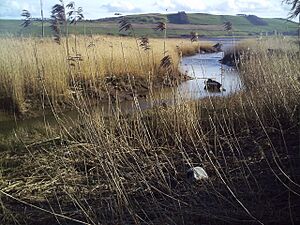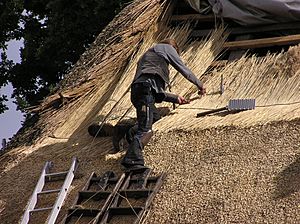Reed (plant) facts for kids
A reed is a type of tall, grass-like plant. Reeds usually grow in wet places, like wetlands, marshes, or along the edges of rivers and lakes. They are known for their strong, hollow stems.
Contents
Different Types of Reeds
Reeds belong to a large group of plants called the Poales. Within this group, many different plant families have species known as reeds. Here are some of the most common ones:
Reeds in the Grass Family (Poaceae)
This family includes many plants we call grasses.
- Common Reed (Phragmites australis): This is the original plant that was named a reed. It grows very tall and is found all over the world.
- Giant Reed (Arundo donax): This reed is very important for making parts of musical instruments.
- Burma Reed (Neyraudia reynaudiana): This type of reed is found in Asia.
- Reed Canary-Grass (Phalaris arundinacea): This grass can grow quite tall and is sometimes used for animal feed.
- Reed Sweet-Grass (Glyceria maxima): This grass grows in wet areas and can be quite large.
- Small-Reed (Calamagrostis species): These are various types of smaller reeds.
Reeds in the Sedge Family (Cyperaceae)
Sedges are plants that look a lot like grasses but have solid, triangular stems.
- Paper Reed or Papyrus (Cyperus papyrus): This famous reed was used by the Ancient Egyptians to make paper. They also used it to build boats.
Reeds in the Cattail Family (Typhaceae)
This family includes plants often seen in marshes.
- Bur-Reed (Sparganium species): These reeds have round, spiky seed heads.
- Reed-Mace (Typha species): Also known as bulrush or cattail, these reeds have a distinctive brown, sausage-shaped head.
Reeds in the Restio Family (Restionaceae)
These reeds are mostly found in the Southern Hemisphere, especially in South Africa.
- Cape Thatching Reed (Elegia tectorum): This reed comes from South Africa and is used for roofing.
- Thatching Reed (Thamnochortus insignis): Another reed from South Africa, also used for thatching.
How Reeds Are Used in Building

People have used reeds to build different kinds of structures for thousands of years. Reeds are strong and grow quickly, making them a good building material. For example, the Marsh Arabs in Iraq still build amazing reed houses today.
Thatching Roofs with Reeds
The common reed (Phragmites australis) is often used to make thatched roofs. Thatching is a traditional way of covering roofs with plant materials. In the United Kingdom, this reed is sometimes called "Norfolk reed." However, some materials called "wheat reed" or "Devon reed" are actually made from wheat straw, not true reeds.
Reeds in Music
Reeds have been used to make musical instruments for a very long time. The Ancient Greeks used Arundo donax to create flutes called kalamavlos. The best reeds for these flutes came from a river in Greece. When several kalamavlos were tied together, they made a syrinx, also known as Panpipes.
Today, Arundo donax is still the main material for making the small vibrating parts, also called "reeds," for many woodwind instruments. These include clarinets, saxophones, oboes, bassoons, and bagpipes. The best reeds for instruments often come from the Var region in southern France.
Other Uses for Reeds
Besides building and music, reeds have other uses. For example, stems from Bamboo and rattan are often used as "reed sticks" in aroma diffusers. These sticks soak up essential oils and spread their scent into the air.
See also
 In Spanish: Caña (vegetal) para niños
In Spanish: Caña (vegetal) para niños




